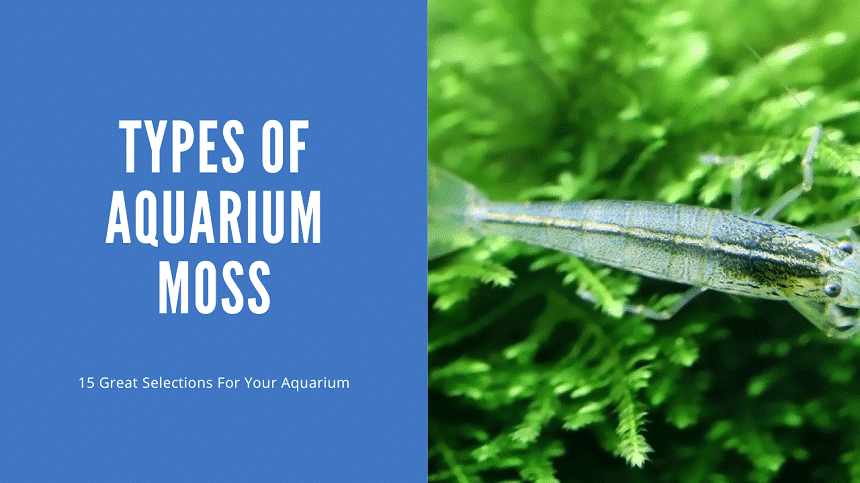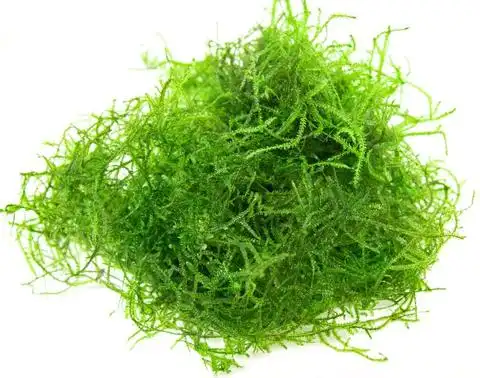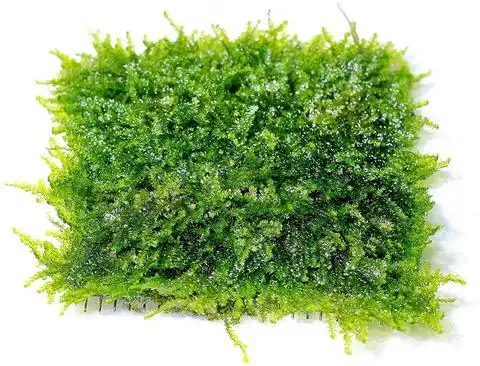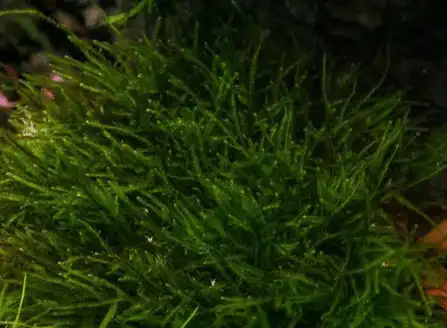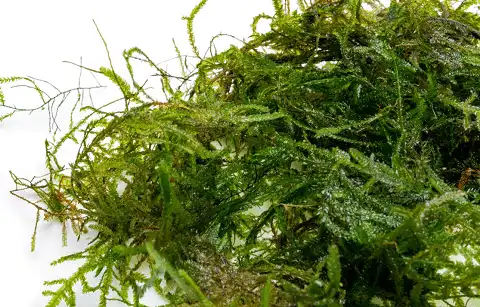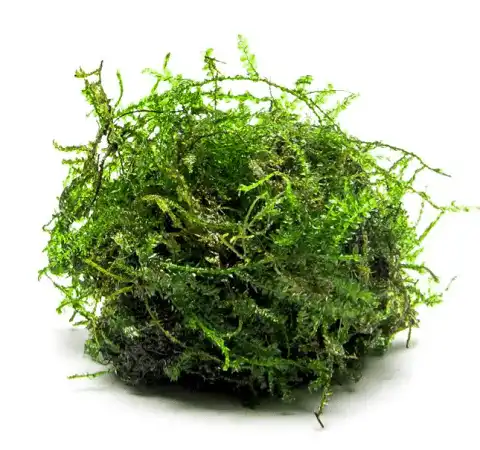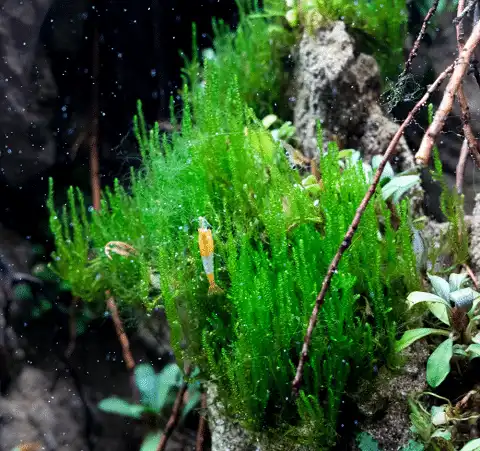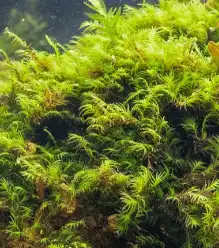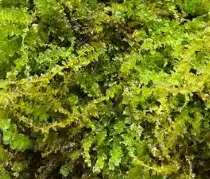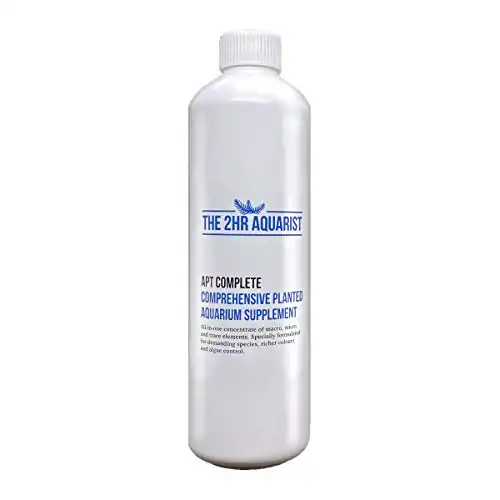Thank you for visiting! By the way… any links on this page that lead to products on Amazon and other stores/partners are affiliate links Aquarium Store Depot earns a commission if you make a purchase.
Have you ever considered growing moss in your fish tank or aquarium? These lush aquatic plants look amazing in an aquascape and provide a number of benefits to the health of your tank. Oh, and they’re also great fun to grow!
In this guide we’re learning about 15 excellent types of aquarium moss and the basics of their care. Let’s dive in!
Key Takeaways
- Aquarium mosses work great for aquascaping and fish/shrimp breeding projects
- They are undemanding aquarium plants but do best with good water flow and cool temperatures
- These plants should not be planted in the substrate. Some species will grow free-floating and others can be attached to your hardscape with glue or thread
- Moss is easy to propagate by division and it may spread itself around in your tank under ideal growing conditions
What Are They?
Aquarium mosses (Java moss, etc.) and liverworts (Pellia, etc.) are non-vascular plants technically known as bryophytes. These delicate plants attach themselves to tree trunks, rocks, driftwood, and riverbanks using anchoring structures known as rhizoids.
Unlike regular plants, aquarium mosses don’t grow flowers, fruits, and seeds but reproduce with spores instead. They also get their nutrients from the water around them instead of using roots.
Benefits
Aquarium moss has many handy benefits for your tank. Let’s take a quick look at some of the reasons you may want to grow these interesting plants.
- Aesthetics
Aquarium mosses can turn an average aquascape into something truly special. From a dark green carpet to what looks like miniature fir tree branches, aquarium moss plants can be used in loads of interesting ways to create an amazing underwater world.
- Water Quality
Like other live aquarium plants, aquatic mosses oxygenate the water while soaking up excess nutrients like nitrates that cause poor water quality. That makes them great for the overall health of your fish and other aquatic pets.
- Breeding
Aquatic Moss is one of the best plants for fish and shrimp breeders because its dense growth creates the perfect spawning site for egg scatterers. Their eggs can remain safely hidden from hungry mouths and the fish fry and baby shrimp can also hang out and feed amongst the foliage.
Keep reading for some basic information about aquarium moss care.
15 Types Of Aquarium Moss
Now that you know the basics of Aquarium moss care, let’s dive right in and learn about 15 awesome species that you can grow!
I supplied a video from our official YouTube Channel so you can get a visual for all these mosses. Our blog goes into further detail so follow along with both to get the full details. If you like our content, be sure to subscribe as we post new videos every week!
1. Java
One of the easiest mosses to grow in an aquarium. Great for small fish and shrimp
- Scientific Name: Vesicularia dubyana
- Origin: Southeast Asia
- Care Level: Beginner
- pH: 6 – 8
- Light: Low-medium
- Temperature: 70 – 75 °F
Java Moss is the perfect species to start with because it is the most popular moss in the aquarium hobby and the easiest to find. This versatile plant is great for aquascaping, breeding projects, or just to provide a great environment for shrimp and small fish to explore.
You can grow this moss attached to your hardscape, as a carpet plant, or even as a living wall on the side or back of your aquarium. This plant has a moderate growth rate and develops long shoots lined with tiny leaves. It survives under a wide temperature range and in either low or bright light.
2. Christmas
A easy to care ground cover plant that is an excellent choice for shrimp tanks
- Scientific Name: Vesicularia montagnei
- Origin: South East Asia and Australia
- Care Level: Beginner
- pH: 6-8
- Light: Low-medium
- Temperature: 72 – 82 °F
Christmas moss is another excellent aquatic species that can be used in a number of aquascaping styles. This attractive bright green plant is perfect for planted aquariums with dwarf shrimp and shy fish that can hide and feed within its foliage.
This species gets its name from its Christmas tree-shaped leaves. It has a neat, compact growth form when grown with sufficient light.
3. Spiky
- Scientific Name: Taxiphyllum sp.
- Origin: Asia
- Care Level: Beginner
- pH: 5.5-8
- Light: Low
- Temperature: 68-82 °F
Spiky moss has an upright growth form which is excellent for adding depth to your aquascape. This fast-growing species has branched shoots similar to Christmas moss but tends to grow larger, reaching a length of about 4 inches. Grow this undemanding moss attached to your hardscape or even emersed in a paludarium.
4. Peacock
Peacock moss is a great moss suited for shrimp tanks. It is less thick then Christmas moss and is a hardy plant
- Scientific Name: Taxiphyllum sp. ‘Peacock moss’
- Origin: Southeast Asia
- Care Level: Easy
- pH: 6-8
- Light: Low-medium
- Temperature: 65-77 °F
Peacock moss is a soft and delicate moss from the Taxiphyllum genus. This beautiful and undemanding aquarium plant has Christmas tree-like leaves.
5. Weeping
Wepping moss is a great choice for shrimp tanks. They grow dense, easy to grow, and have slower growth rates. A hardy and shrimp friendly plant
- Scientific Name: Vesicularia ferriei
- Origin: Eastern Asia
- Care Level: Beginner
- pH: 6 – 8
- Light: Low-high
- Temperature: 59-86 °F
The weeping moss (Vesicularia ferriei) is a slow-growing East Asian species with a beautiful drooping form like a weeping willow tree. You are most likely to achieve this interesting form in your tank when grown under sufficient lighting, although this species can survive in low light. Attach this low-growing species to driftwood with thread or super glue for the best results.
6. Flame
Flame moss is a creeping plant that does well in shrimp tanks. An easy to grow plant that is slow growing and low maintenance
- Scientific Name: Taxiphyllum sp. ‘Flame moss’
- Origin: Southeast Asia
- Care Level: Easy
- pH: 6-8
- Light: Low-medium
- Temperature: 54-86 °F
Flame moss is a unique species that grows spiraled, upright stems that resemble flames. This slow-growing aquatic species can be grown both emersed and submerged and makes the ideal plant for a nano aquarium with shrimp or small fish.
Flame moss is a hardy species that reaches a height of 3 to 4 inches if left untrimmed. This decorative plant is suitable for beginners, although it will do best in stable water parameters and gentle water flow conditions.
7. Phoenix
Phoenix moss is a new moss to the scene. Prefers low temperatures and can be planted directly into the substrate
- Scientific Name: Fissidens fontanus
- Origin: North America
- Care Level: Easy
- pH: 6-8
- Light: Medium
- Temperature: 64 -77°F
Phoenix moss is a North American moss with loads of uses in the aquarium. This aquarium moss has a delicate feathered appearance that adds amazing texture to any aquascape!
You can secure this moss to your hardscape with gel super glue or fishing line or you can weigh it down and let it attach itself to your substrate. It will also spread itself around in your tank naturally although it stays low and needs little maintenance.
8. Pearl
Pearl moss is a slow growing moss that is available in tissue culture formate. This is the best moss to consider if you want a pest free tank
- Scientific Name: Plagiomnium affine
- Origin: Europe
- Care Level: Easy
- pH: 5-8
- Light: Low
- Temperature: 50-86 °F
Pearl moss is an attractive aquatic plant that grows long fine stems with small round leaves. This very slow-growing European moss species is ideal for low-light conditions.
Pearl moss is a pretty rare species thats good for the aquarist who enjoys the challenge of growing a variety of different aquatic plant species. Its easy to propagate but will not spread as well as vigorous species like Java moss.
9. Round Pellia
- Scientific Name: Monosolenium tenerum
- Origin: East Asia
- Care Level: Easy
- pH: 6-8
- Light: Low to medium
- Temperature: 64 – 79 °F
Monoselenium tenerum is an attractive Asian plant from the liverwort family with a deep green colour. It does well in low light conditions and can be grown as a free-floating plant or tied/glued to wood and other objects in planted aquariums.
This plant should not be confused with Subwassertang, a similar looking fern which is also known as round pellia.
10. Mini Pellia
- Scientific Name: Riccardia chamedryfolia
- Origin: Asia
- Care Level: Beginner/intermediate
- pH: 6-8
- Light: Low-medium
- Temperature: 64-82 °F
Mini pellia is often called coral moss, although it is actually a liverwort rather than a true moss. This delicate, deep-green species grows low stems that create interesting effects on driftwood and other hardscape features in a planted tank.
Mini pellia can grow and spread quickly once it is established in an aquarium and will look its best if given medium light and carbon dioxide. However, its not a good moss choice for warm water temperature ranges above 82°F
11. Mini Club Moss
- Scientific Name: Selaginella Kraussiana
- Origin: Africa
- Care Level: Easy
- pH: N/A
- Light: Low-medium
- Temperature: Tropical
Mini clubmoss is a handy species for vivariums and paludariums because it requires high humidity but does not grow submerged in the water. This compact plant reaches a height of just two inches and has beautiful fern-like foliage.
Mini-club moss requires deep, moist soil to root and grow. Try this interesting plant for the land section of your paludarium or vivarium setup!
12. Fissidens Nobilis
- Scientific Name: Fissidens nobilis
- Origin: Asia
- Care Level: Easy
- pH: 6-8
- Light: Medium
- Temperature: 64-79 °F
Fissidens nobilis is a dark green moss that develops a strong attachment with its rhizoids. This Asian species is a great choice for the bottom of your tank or for the driftwood and other hardscape features in your aquascape.
Fissidens nobilis has a very slow growth rate and looks pretty similar to the phoenix moss (Fissidens fontanus) although it grows larger and more upright feathery fronds.
13. Ruby Red Club Moss
- Scientific Name: Selaginella erythropus
- Origin: South America
- Care Level: Easy
- pH: N/A
- Light: Low-medium
- Temperature: Tropical
The ruby red club moss is another interesting option for vivarium and terrariums. The lower surfaces of this terrestrial moss’s leaves are a beautiful ruby-red color that contrast with the dark green uppersides. Club mosses thrive in moist well-drained soil but they should not be grown submerged under the water in an aquarium.
14. Crystalwort
- Scientific Name: Riccia fluitans
- Origin: Cosmopolitan
- Care Level: Easy
- pH: 6-8
- Light: Low-medium
- Temperature: 68-81 °F
Popularized by aquascaping legend Takashi Amano, crystalwort is an interesting aquatic species that can be grown as a floating plant or attached to driftwood or stainless steel mesh. Riccia fluitans is not a true moss, although it has a similar appearance and growth form in the aquarium (video source).
This plant grows fast and develops an attractive branching pattern of narrow bright green leaves. It does not need CO2 or intense lighting if grown as a floating plant, although it will do better in a high-tech setup if grown attached to rocks or driftwood at the bottom of your tank.
15. Willdenow’s Spikemoss
- Scientific Name: Selaginella willdenowii
- Origin: Southeast Asia
- Care Level: Easy
- pH: N/A
- Light: Low-medium
- Temperature: Tropical
Willdenow’s spikemoss is a large terrestrial species that makes an interesting choice for a terrarium or vivarium setup (video source). This attractive plant grows rooted in the soil and requires fairly shady and moist growing conditions. Unfortunately, this species will not survive if grown underwater.
Other Popular Species
- Nano moss – Amblystegium serpens
- Taiwan moss – Taxiphyllum alternans
- Marimo moss ball
- Stringy moss – Leptodictyum riparium
Basic Care
There is no specific combination of techniques and parameters that are perfect for every species, but these general guidelines are a good starting point for most aquatic mosses.
- Lighting
Most mosses can thrive under a variety of lighting and they are one of the few good options for low-light tanks. Some species even survive under ambient light conditions in well lit rooms, although they should never be exposed to direct sunlight.
Current USA's offering into aquascaping is an incredible value. Spectrum, spread, easy to program and great PAR output.
- Temperature
Aquatic mosses are highly adaptable plants that can grow in a wide range of temperatures. However, most aquarists get the best results in heated aquariums with stable water temperatures in the low to mid-70s Fahrenheit. Algae and melting can become a problem at higher temperatures.
Different species prefer different temperatures so choose a moss that will fit in with the other species in your tank. For example, Willow moss prefers cold water below 68 degrees Fahrenheit, while Java moss can survive in the lower 80s Fahrenheit.
- Feeding
Aquarium mosses do not gather nutrients from the substrate like regular rooted plants. Instead, they get the nutrients they need from the water column and from waste and detritus particles that settle among their foliage.
Regular dosing with a liquid fertilizer is recommended for healthy growth, but avoid overdoing it as this could result in poor water quality and algae blooms.
Editor's Choice
Made by an aquascaper for aquascapers. This is the best all around aquarium plant fertilizer on the market. Marco and micronutrients in one bottle!
Use Coupon Code ASDComplete for 10% off your order!
- CO2
Aquarium moss needs carbon dioxide, just like other plants, and they will benefit from increased levels. However, pressurized CO2 is not necessary unless you are using strong lighting.
- Water Flow
Moderate to strong water flow will help prevent too much waste settling within your moss, and increase aeration and nutrient flow to all parts of the plant. However, moss are delicate plants that can be damaged or break loose in very strong water flow, especially when they are still developing healthy rhizoids.
Attachment
Keeping aquarium moss fixed in place can seem impossible until you learn a few simple tricks. It’s important to understand that these plants do not grow regular roots into the soil, so most species must be attached to the hardscape (rocks, driftwood, decorations ) or simply left to float in the water column.
I’m going to share this wondering walkthrough video by Daniel Keepfish Fish that shows how he attaches moss to driftwood and other structures. It’s a must watch!
You can tie or attach moss to rocks and driftwood with gel super glue, thread or fishing line. Separate and attach the plant in very thin sections, as thick clumps tend to rot from the inside. You can also sandwich moss between stainless steel or plastic mesh and use it as a carpet or even a living wall. Some examples of driftwood would include:
- Spider wood
- Manzanita
- Tiger wood
We’ll cover the process of growing an amazing wall a little later in this guide, so keep reading to learn about this amazing technique!
Propagation
Mosses are very easy to propagate, so you can grow large amounts from a small piece if you have the patience. The easiest method is to simply divide the plant and attach these divisions to other parts of the hardscape in your tank.
They can also spread themselves around the tank by releasing spores or when small sections break apart, drift around, and anchor themselves.
Maintenance
Depending on the species, you may need to trim your aquarium moss regularly to keep it neat and healthy. Don’t wait for it to grow too long and dense before trimming because the inner areas can die off if they don’t have access to light and water flow.
Trimming moss can get pretty messy as all the tiny offcuts go drifting around in the tank. Be sure to switch off your filter and powerheads during this process to avoid clogging up the inflow and media. You can use a fine mesh net or suction from a hose or gravel vacuum to remove the offcuts as you go.
Uneaten food, fish poop and other waste often settles among moss leaves and stems where it can decay and cause water quality issues. Remove this material with your gravel vacuum or stir it loose by waving your hand just above the plant during water changes.
Tankmates
Aquarium moss is delicate and can be damaged by large boisterous fish like plecos and bottom feeders that like to root around for food buried in foliage and substrate. However, a clean-up crew of nano species like otos, kuhli loaches, or dwarf shrimp is very helpful for keeping your moss clean and healthy.
Bonus – How To Create An Wall
Growing an aquarium moss wall is one of the most interesting and effective ways of using aquarium moss in a planted tank. However, aquarium mosses will not simply attach themselves to glass, so you’ll need to make some preparations to achieve this awesome effect.
Continue reading to learn how to create your own Aquarium moss walls!
- Step 1 – Select your moss species
Weeping moss (Vesicularia ferriei), Flame moss (Taxiphyllum sp. ‘Flame moss’), Christmas moss (Vesicularia montagnei), and many others can be used for your moss wall. Choose a species that appeals to your individual vision for the tank.
- Step 2 – Sterilize your moss
If you don’t have sterile tissue culture moss, you may wish to sterilize the moss before adding it to your tank. This will minimize the chance of snails and other unwanted organisms getting into your aquarium.
A weak bleach dip (1 part bleach: 20 parts water) is recommended. Make sure to rinse your moss thoroughly with dechlorinated water after dipping to remove all excess bleach or peroxide.
- Step 3 – Measure and cut mesh
You will need two panels of fine stainless steel or aquarium-safe plastic mesh cut to the size of your wall. Each panel should be the same size since you will be creating a moss sandwich to hold everything together.
- Step 4 – Pack in your moss
Arrange your moss on one mesh panel, being careful to keep it cool and moist. You don’t need to cover 100% of the mesh, but avoid overfilling as you need good water movement to the moss.
- Step 5 – Secure the other mesh panel
Next, it’s time to close the ‘sandwich.’ Use staples, small zip ties, or a needle and fishing line to hold everything together. Remember to mist your moss regularly during the process to prevent shock.
- Step 6 – Installation
Now it’s time to secure your moss wall to the glass. If you’ve made a wall that is long enough to cover the back and both sides, it might stay in place without any effort.
You can also peg or secure a single panel to the glass along the top rim of the tank and secure it along the bottom with rocks and driftwood. Suction cups work too, but try to get your wall attached as flush to the glass as possible to prevent any fish or shrimp getting trapped.
- Step 7 – Patience
You know what they say, good things come to those who wait! If all goes well, it’s going to take a few months for the moss to grow through the mesh and create a full wall. Keep the water temperature and parameters stable during this period, and enjoy watching your living wall come to life!
For a visual aid of all this, I’ll share this video from ThatShrimpDude that shows him setting up his own Moss Wall. Follow along to see how these steps are implemented visually.
Maintenance
Once your moss wall is well established, you may need to trim it down from time to time to keep it neat. However, this is going to depend on which type of moss you use because some slow-growing species stay short and compact while others may become stringy.
It’s best to use a pair of curved aquascaping scissors for this job- it’s what they’re designed for. Try to remove all the moss trimmings as you cut them, that way they won’t drift around and spoil in your tank. A gravel vacuum is effective for this job, but a small fine mesh net is easier if you’re working alone.
FAQs
What is the best moss for an aquarium?
Java moss is one of the best aquarium mosses because it’s highly versatile, easily available, and very affordable! This species can be used for everything from accents in carefully crafted aquascapes to live spawning mops in commercial fish breeding projects.
What is the best moss for an aquarium moss wall?
You could try just about any aquatic species for a moss wall, although in my experience, Christmas moss is the easiest to handle and maintain. Java moss, while beginner friendly, it’s not as clean as Christmas moss when it comes to presentation.
Is moss good for a fish tank?
Healthy aquatic moss growth is great for any freshwater fish tank. It provides many benefits, including improved water quality, natural food and hiding spots for your fish and shrimp. Aquatic moss also looks beautiful in any aquascape and it’s really fun to grow!
What is a good alternative to Java moss?
Christmas moss (Vesicularia montagnei) is a great alternative to Java Moss. This species has a neater growth form resembling a Christmas tree. It has a slower growth rate but that also means less maintenance in the long run.
What is the easiest moss to keep in an aquarium?
Java moss (Taxiphyllum barbieri) is generally the least demanding moss species to keep and an excellent choice for a beginner. This is an extremely popular aquatic moss species.
What is the most hardy moss in a fish tank?
Java moss (Taxiphyllum barbieri) is a very hardy species that can survive in a huge range of water temperatures, parameters and light intensities. This species is also relatively fast-growing.
Final Thoughts
There’s nothing like the deep greens of healthy aquarium moss to add that extra dimension to a planted aquascape. These interesting plants benefit our freshwater aquariums in so many ways that every aquarist should consider adding some to their tanks. I hope this guide has inspired you to try growing one of the many amazing types of moss available in the aquarium hobby today!
Do you grow moss in your fish tanks? Tell us about your favorite aquarium moss species!
- About the Author
- Latest Posts
I’m thrilled that you found Aquarium Store Depot! Here you’ll find information on fish, aquariums, and all things aquatics related. I’m a hobbyist (being doing this since I was 11) and here to help other hobbyists thrive with their aquariums! I adhere to a high quality Editorial Process and Review products with real life field usage and practical analysis.

